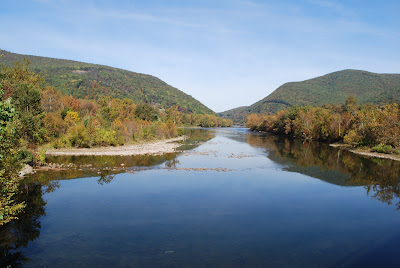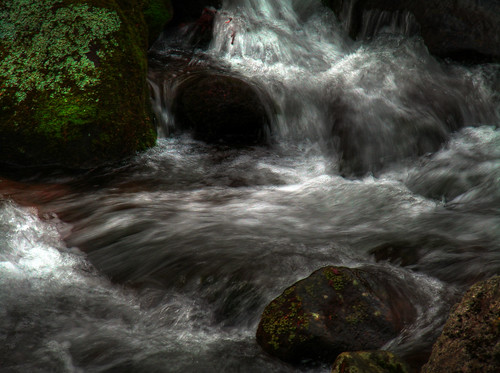I didn't see a posting for the next discussion, but I wanted to get these out of the way. Anyway, here are my summaries:
Dolinsek, I. J., J. W. A. Grant and P. M. Biron. 2007. The effect of habitat heterogeneity on the population density of juvenile Atlantic salmon Salmo salar. Journal of Fish Biology 70: 206-214.
Kalleberg, E. R. 1958. Observations in a stream tank of territoriality and compensation in juvenile salmon and trout (Salmo salar L. and S. trutta). Report of the Institute of Freshwater Research Drottingholm 39: 55-98.
In a manipulative field experiment, Dolinshek et al. (2007) tested the Kalleberg (1958) hypothesis that for juvenile Atlantic salmon visual isolation reduces territory size and subsequently increases density. Dolinshek et al. (2007) hypothesized that if visual isolation is the primary mechanism controlling density in salmon, and not habitat heterogeneity or habitat quality, changes to a habitat that affect visual isolation should have no effect on non-salmonid density because such fish do not defend territories, but should affect density of coincident salmonids. They manipulated streams by adding or removing boulders from test plots. Boulders were assumed to provide sufficient visual isolation. They found that adding boulders increased salmon density, but had little effect on non-salmonids, thus supporting Kalleberg’s hypothesis.
Elliott, J. M. and M. A. Hurley. 1998. Population regulation in adult, but not juvenile, resident trout (Salmo trutta) in a Lake District stream. Journal of Animal Ecology 67: 280-286.
In previous work, Elliott and Hurley (1998) found that one of two extensively documented trout populations studied in the English Lake District was clearly controlled by density-dependent factors in early life stages (competition among individuals that recently emerged from redds). In the second population, which had a lower overall density, this density-dependent relationship was not observed, so they tested whether density-dependence at a later life stage, reproductive females, controlled populations. Specifically, they studied the relationship between how many females laid eggs each year and the number of successfully spawning females that resulted from that year’s recruitment. When female density exceeded 4 per 300 m2 their offspring produced fewer females and eggs. Documentation of later life density-dependence in salmonids is rare and the specific mechanisms remain unknown, though Elliot and Hurley (1998) speculate on a few.
Orth, D.J., and T.J. Newcomb. 2002. Certainties and uncertainties of defining essential habitats of riverine smallmouth bass. Pages 251-264 in M. S. Ridgway and D. P. Phillipp, eds. Black Bass: Ecology, Conservation, and Management. American Fisheries Society, Bethesda, MD.
Sorry to diverge from the Precis approach, but I just could not do this article justice via that summary format. Orth and Newcomb (2002) present concepts germane both to our discussions of habitat ecology and population ecology in stream habitat management.
On Habitat Ecology:
Orth and Newcomb (2002) use the inconsistencies and consistencies of observed habitat associations in Virginia and West Virginia streams to draw conclusions about the physical and biological processes that create and maintain habitats for SMB. For example, physical habitat measures of nest sites (depth, velocity, proximity to banks, etc,) varied by river, but all relationships were related to refugia for both adults and offspring. Nests in deeper habitats with greater cover protected adults from avian prey. Nests were also more common in areas less likely to be affected by violent flows, thus providing flow refugia for eggs. The conceptual connections presented in this example are writ large in Orth and Newcomb (2002) as they look at habitat use for all important life stages of SMB (nesting, early development, juvenile, and adult) and also at habitat needed to sustain a SMB forage base.
On Population Ecology:
In the first portion of their paper, Orth and Newcomb (2002) briefly review some factors known more globally to affect recruitment to and structure of SMB populations. However, in discussion of habitat associations they more narrowly hypothesize links between habitat and population structure, demonstrating the importance of density-independent mechanisms on SMB populations. For example, they hypothesized that SMB population structure is the product of stochastic processes, such as rare and extreme flow events, and habitat quality, such as suitable nest sites. They also discuss the link between habitat for forage and success of populations. For example crayfish density can affect adult SMB density. Thus, habitat quality for crayfish can control SMB populations.
In summary, Orth and Newcomb (2002) expose the danger of the assumption that because an animal appears to be habitat generalist, that population dynamics are not affected by density-independent mechanisms indirectly or directly related to habitat quality.



























